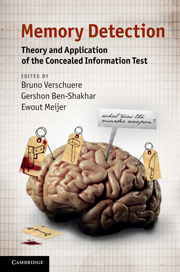Book contents
- Frontmatter
- Contents
- List of figures
- List of tables
- Notes on contributors
- Acknowledgments
- Part I Introduction
- Science on the rise: birth and development of the Concealed Information Test
- 1 Encouraging the use of the Guilty Knowledge Test (GKT): what the GKT has to offer law enforcement
- Part II The laboratory: theoretical and empirical foundations of the Concealed Information Test
- Part III Field applications of concealed information detection: promises and perils
- Part IV Conclusions
- Index
Science on the rise: birth and development of the Concealed Information Test
Published online by Cambridge University Press: 05 June 2012
- Frontmatter
- Contents
- List of figures
- List of tables
- Notes on contributors
- Acknowledgments
- Part I Introduction
- Science on the rise: birth and development of the Concealed Information Test
- 1 Encouraging the use of the Guilty Knowledge Test (GKT): what the GKT has to offer law enforcement
- Part II The laboratory: theoretical and empirical foundations of the Concealed Information Test
- Part III Field applications of concealed information detection: promises and perils
- Part IV Conclusions
- Index
Summary
Intrigued by the polygraphic equipment in my laboratory, my two assistants had asked if I did any lie detector work and I had been forced to admit that I knew nothing about the subject. Equipped as we were with time, facilities, and ignorance, we resolved to do an experiment on lie detection.
(Lykken, 1981)In 1959, University of Minnesota psychology professor David Lykken reported an experimental study of a new type of lie detector test that he termed the “Guilty Knowledge Test” (GKT). As indicated in the foregoing quote from his 1981 book, Lykken was unfamiliar with established methods of lie detection used by police and other field examiners at the time of this study. As a result, he relied upon basic principles of experimental psychology to devise a test that focused on probing for specific relevant knowledge of the incident under investigation rather than on detection of lying per se.
A cornerstone of Lykken's technique was the fundamental concept of experimental control: to ensure that the observed (“dependent”) effect is attributable to the experimental (“independent”) manipulation, one must establish a comparison condition that mirrors the experimental condition in all respects aside from the manipulation of interest. With this principle in mind, the GKT was composed of items in multiple-choice format, with alternative choices for each item (one of them crime-relevant, the others extraneous) formulated to appear equally plausible to an innocent examinee.
- Type
- Chapter
- Information
- Memory DetectionTheory and Application of the Concealed Information Test, pp. 3 - 11Publisher: Cambridge University PressPrint publication year: 2011
- 1
- Cited by



